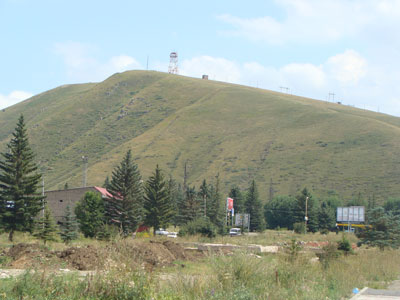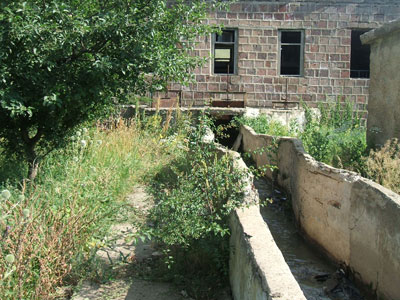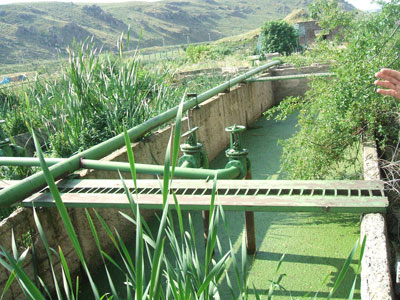
Citizen Initiative: Hrazdan Residents Launch Petition to Halt Iron Mine
The hill seen in this photo is located in the town of Hrazdan (Kotayk Marz). The hill is the site for a new iron ore mine and enrichment plant. Explosives will be used to unearth the iron veins below.
The photo shows just how close the mine will be to the town. The town is laid out in such a fashion that it encircles the hill. The neighborhoods of Vanatour, Banavan and Akhpara literally reach the sloops of the hill.  There are other communities close to the proposed mine – Kaghsi, 4 kilometers away; Solak, 6 and Lernanist, 5.5. The Sevan-Hrazdan viaduct runs just over ½ kilometer away from the mine’s production facility and the Hrazdan River itself is only 1.5 kilometers distant. There are also a number of tourist centers in Kotayk Marz – Tzaghkadzor and Hankavan, where numerous investments have been made in the tourist sector. Nevertheless, despite the fact that the area is important from an environmental and tourist point of view, the “Nagin” company has received a favorable environmental impact assessment from the RoA Ministry of Nature Protection. Currently, all the legal possibilities to freeze the operation of the mine have effectively exhausted for the most part.
There are other communities close to the proposed mine – Kaghsi, 4 kilometers away; Solak, 6 and Lernanist, 5.5. The Sevan-Hrazdan viaduct runs just over ½ kilometer away from the mine’s production facility and the Hrazdan River itself is only 1.5 kilometers distant. There are also a number of tourist centers in Kotayk Marz – Tzaghkadzor and Hankavan, where numerous investments have been made in the tourist sector. Nevertheless, despite the fact that the area is important from an environmental and tourist point of view, the “Nagin” company has received a favorable environmental impact assessment from the RoA Ministry of Nature Protection. Currently, all the legal possibilities to freeze the operation of the mine have effectively exhausted for the most part.
Residents fear signing the petition
“We have already started a petition drive to collect signatures with the aim of preventing the opening of the mine,” says Edgar Yengibaryan, Coordinator of the “Arhaus” Hrazdan Environmental-Informational Center. Mr. Yengibaryan adds that many more residents of Hrazdan would sign the petition if they weren’t afraid of being fired from their jobs or of other consequences. Hrazdan is a town of 57,000 and to date only 1,500 residents have signed on to the petition. In addition to the fact that the mine is close to the town, there are other reasons of concern to representatives of various Hrazdan-based NGO’s. In particular, it is noted in the experts’ assessment of “Nagin Ltd’s” draft work plan for the mine that waste water from production will be pumped through a Hrazdan cleaning station via a collector unit not far from the village of Kaghsi.  “That collector hasn’t been working for many years and waste water merely flows through and spills into the Hrazdan River without being filtered,” Mr. Yengibaryan says, showing photos of the dilapidated structure.
“That collector hasn’t been working for many years and waste water merely flows through and spills into the Hrazdan River without being filtered,” Mr. Yengibaryan says, showing photos of the dilapidated structure.  There is also another concern. Mr. S. Amirkhanyan, Chief of Staff at the RoA Ministry of Nature Protection wrote, in a letter addressed to the “Arhaus” Center in Hrazdan that the site is only a mine for “black metal” and that the mine contains no other metal ores”. Assistant Professor Ruben Movsesyan, Head of the Chair of Mine Exploration and Investigation at Yerevan State University’s Faculty of Geography and Geology, states that in the extraction of useful mineral ores, including iron, the process always includes more than one ore. Then too, in the work entitled “Mineral Resources in Armenia”, by H.S. Avagyan, there are statistics showing joist how rich the mine is in a number of various ores: zinc-22,554 tons, titanium-20,398, copper-11,553, cobalt-7,628, zirconium-1,160 tons, calcium-497 tons, nickel-387, silver-124 tons, etc. There are some 161,120,000 tons of pure iron ore in the mine. Since Nagin Ltd. plans to extract only iron ore for processing, this means that the other ores will wind up in the tailings reservoir located some 500 meters from the town.
There is also another concern. Mr. S. Amirkhanyan, Chief of Staff at the RoA Ministry of Nature Protection wrote, in a letter addressed to the “Arhaus” Center in Hrazdan that the site is only a mine for “black metal” and that the mine contains no other metal ores”. Assistant Professor Ruben Movsesyan, Head of the Chair of Mine Exploration and Investigation at Yerevan State University’s Faculty of Geography and Geology, states that in the extraction of useful mineral ores, including iron, the process always includes more than one ore. Then too, in the work entitled “Mineral Resources in Armenia”, by H.S. Avagyan, there are statistics showing joist how rich the mine is in a number of various ores: zinc-22,554 tons, titanium-20,398, copper-11,553, cobalt-7,628, zirconium-1,160 tons, calcium-497 tons, nickel-387, silver-124 tons, etc. There are some 161,120,000 tons of pure iron ore in the mine. Since Nagin Ltd. plans to extract only iron ore for processing, this means that the other ores will wind up in the tailings reservoir located some 500 meters from the town.
Air pollution also a concern
Then too, the air pollution issue is also of concern. Nagin Ltd. hasn’t conducted any air quality studies of its own. Rather, it has used air monitoring statistics of the Nature Ministry’s “HayEcoMonitoring” Center. According to the Center’s figures, during research conducted in 2009, the number of cement particles in the air surpasses normal levels by 2 – 6.5 times. Added to this will be the other pollutants released into the air when the mine site is opened via detonation. Regarding what will happen to the water resources, the research isn’t conclusive. Unlike the air quality studies, it was Nagin Ltd that carried out the water impact studies. We compared the normal concentration levels used in Nagin’s documents with those used in reports by the “HayEcoMonitoring” Center’s Environmental Impact Assessments. It turns out that the levels used by Nagin in their studies differ from those used by the Center. It should be noted that the Center’s norms are always the same. For example, in Nagin’s study it states that the acceptable level of manganese in water is 0.1miligramper liter, while the Center cites 0.001 milligram per liter as borderline acceptable. Nagin Ltd cites 3.3mg/liter as the norm for nitrate-ion but the Center cites 0.02mg. The company uses a chromium norm level of 0.5mg per liter of water but the “HayEcoMonitoring” Center cites a mere 0.001mg. This leads Edgar Yengibaryan to conclude that the normal concentration levels appearing in Nagin Ltd’s documents have been doctored. The conservative stance of the RoA Ministry of Nature Protection is quite evident for all to see. Ministry Chief of Staff S. Amirkhanyan answered that the normal concentration levels used by the “HayEcoMonitoring” Center for surface water sites do not correspond with accepted norms for use on RoA territory. “Thus, the question arises why is the Center conducting any environmental monitoring in the first place if the standards it uses are incorrect and, if this is the case, why are the Center’s findings published on the Nature Ministry’s website as official information?” asks Mr. Yengibaryan of the Hrazdan “Arhaus” NGO See related article:
New Hrazdan Mine Fulfills the Dream of Former Environment Minister Vardan Ayvazyan
 Videos
Videos Photos
Photos
Write a comment